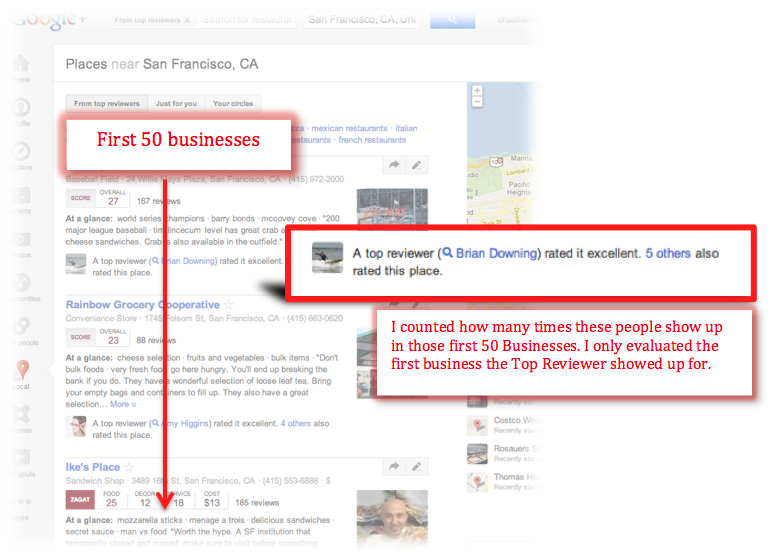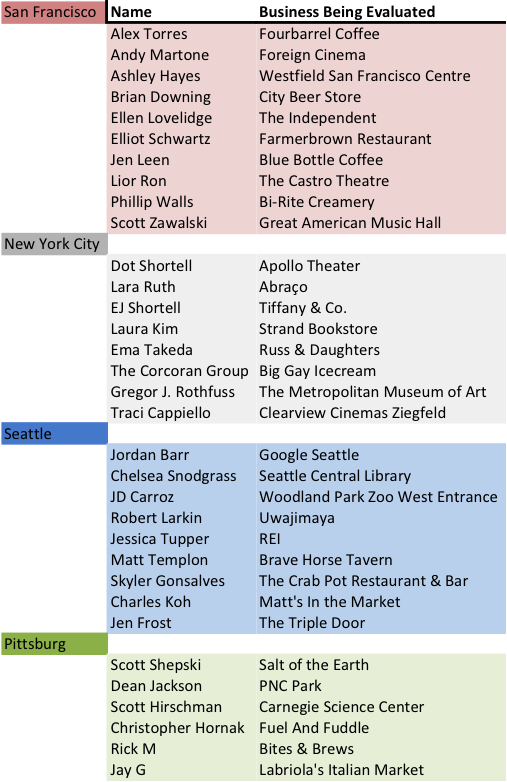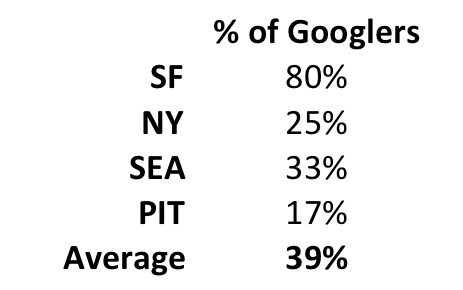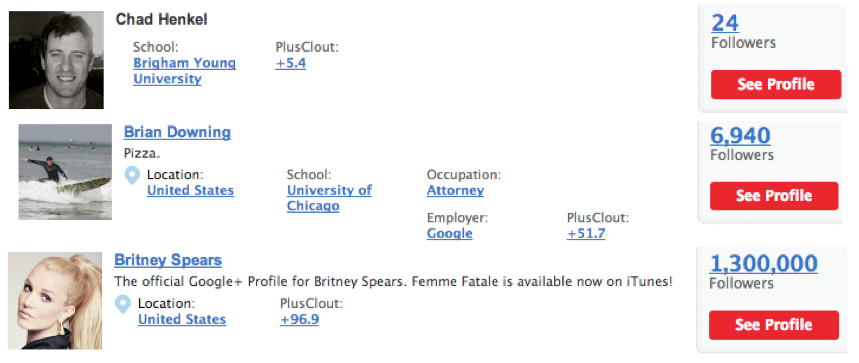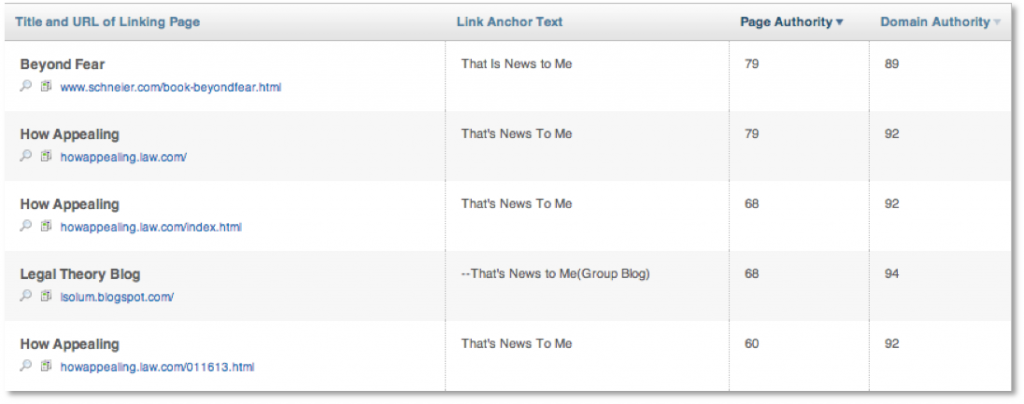Ya, it didn’t surprise me in the least. “G+: the wave of the future” (or something), is being sandbagged in certain markets. Deep in the books of Google Lore – employees are being paid to make Google Plus successful by being hyper active in certain markets that Google has offices in. Their year end bonus is tied to Google+ performance! AHHHHHHHHHHHH!!!!!!
OK. Seriously though. It was an interesting find here at Nifty. The data I managed to scrounge up is even more interesting. I’d like to unravel a few things that may be helpful to our local search community and internet marketers in general. Beginning with the end in mind – here’s why I wanted to share this with everyone: Google+ and G+ local are growing in importance and as such we should know who has influence on the platform to make it successful or make it suck.
First off – let me explain how I stumbled upon this blog post idea:
One day, as the Niftys and I were having a pow-wow in our old office space (rest in peace) we were exploring some new ideas on how to do local outreach. We were considering different ways to find authorities in local markets and it just so happened we were exploring the San Francisco G+ Local scene. An odd thing kept popping up as we were looking for “Top Reviewers” in the market to connect with. We kept finding Google employee after Google employee that was considered a “Top Reviewer”. Well this happened over and over and over again. Really, we thought it was an anomaly. Eventually, chirping crickets followed our amazement and we knew we were sitting on a GOLD mine of conspiracy and outright scandal.
Andy, I totally agree.
I told myself that if I’m alive, after completing this research, come February/March – I’m going to write an exposé and unravel the Google Plus Top Reviewers Conspiracy. After several assassination attempts here I am and it’s going down!
It should be noted that I selected the cities that Google has operated in for the longest period of time, hoping these cities would have the highest concentration of Google employees. If I found someone that had a “techie” job title but no company I’d do some ninja scrubbing by checking LinkedIn and finding their employment information. Creepy? Maybe. I was able to uncover several undercover employees this way…I am learned in G+ stalking – that’s for sure. Did you know that you can keep notes on people you don’t have in Circles? Below is Brian Downing’s G+ About page (in the footer area) – he happens to be an in-house Google lawyer. I have dubbed this the “creepster” section of a G+ profile. …Google enables creepiness – just sayin’.
For my purposes I wanted to examine how concentrated the 50 businesses were with Google employees in a given city and also how many were Top Reviewers. Here’s how I pulled the default top reviewers for the first 50 businesses in New York (and other cities) is as follows:
1. Search G+ Local by adding the city you want to find Top Reviewers in:
2. Type in “top reviewers” here:
3. Now select Click top reviewers here:
4. Now erase top reviewers from here and you’ll have the default 50 businesses that I used to compile this research.
So at this point I selected the first 50 businesses and counted how many times each person (see below) happened to be a Top Reviewer. Once I knew who the Top Reviewers were for each city I only evaluated the 1st occurrence where the Reviewer showed up for a particular business as a Top Reviewer and evaluated that businesses reviewers.
Here’s the Original Top Reviewers and Businesses being evaluated for each city using the above process:
The overall scope of this research is to measure how concentrated Google employees are in a given market and then make all sorts of accusations on how they are loading the dice and making small biz owners’ lives difficult.
I set off on my carpal tunnel journey with a mere hope – that it would be glaringly obvious that Google is using their own forces to make G+ successful in certain markets. Will the data support that assumption? Or will I be humbled? Dun dun DUNNNNNNNNN!!!!
Here’s the scope of the research:
Cities examined:
- San Francisco
- Pittsburgh
- Seattle
- New York City
I did basic research on 3 different levels of G+:
- Google+ Local Places Aggregate Level
- Google+ Local Business Page Level – Reviews 1-6
- Google+ Local Business Page Level – Review 7-16
I’ve outlined each of the above levels with a series of questions that I wanted to find out before researching. They precede the data. I also summed up some key take aways from each section as well.
Side Note: Here’s another fun tool to get some additional insight – http://www.gplusdata.com/
I discovered this tool as I was doing ninja recon work – it’s AWESOME. Wish I had this earlier in the process because they have a cool metric “PlusClout” – now, I don’t know what makes the PlusClout calculation but they do give a pretty good snapshot of the number of Google+’ers (G+’ers) for each city.
Let’s jump into some of the research and see what aces are up Google’s sleeve…
1. Places Level (Find the Top Reviewers for first 50 businesses)
Top Reviewers:
- Who were the “Top Reviewers” for each city?
- How many reviews did they have under their belt?
- Were they a Google Employee?
- How many times were they a “Top Reviewer” in the city’s first 50 default businesses?
Below is the original set of Top Reviewers I used to conduct the analysis, whether they were Google employees, the number of times they showed up in the top 50 businesses I pulled up, and the number of reviews they each had.
Yes – that is correct – 8 of the 10 people who were listed as Top Reviewers for San Francisco businesses were Google Employees. Of those 8 – they dominated all but 10 spots in the Top 50 default businesses I reviewed. I’ll delve into this data more below. Furthermore, each city has at least 1-2 dominant reviewers but they aren’t always Google Employees! Awe shucks. That’s really the least interesting thing though as this study really looks at things as they correlate in the aggregate.
Key Take Aways – Crunchin’ Numbers So You Don’t Have To
Think about it – there are ~38,585 people in San Francisco using G+ (thanks findpeopleonplus.com) and 80% of the “Top Reviewers” are Google employees! Even if you average these numbers out (39%) it’s still a staggering number.
I wanted to just show the PlusClout score and compare myself to a G+ Top Reviewer and an A-list celebrity: Britney Spears (leave her alone!), and Brian Downing, a decorated Top Reviewer on G+ in San Francisco and Google employee. If only you could get a review from Britney Spears (good luck, I searched her profile and her peeps don’t leave ‘em). However, let’s say you network with Top Reviewers: you can imagine how powerful it’d be to have Brian (or any Top Reviewer) going to bat for your business – memorize his face…and make sure he get’s his coffee the way he wants it! Your business may rest in his hands.
Another interesting post would be researching these businesses and seeing how they rank and if these Top Reviewers have any influence or indication of increasing ranking which is outside the scope of this post. But here is one thing that IS super useful in analyzing Top Reviewers for link outreach opportunities in specific niches. Let’s take a stroll down Brian Downing’s G+ profile and see what we can glean…
1. Go to the About page
When researching a G+ member for outreach opportunities it’s important to learn about them as much as humanly possible. You want to connect, see what’s interesting to them, and overall take note on what they have their hands in. You’ll learn amazing things! Here’s a little snapshot of Brian Downing’s G+ About page. Notice the Links section:
2. Be Observant
I love the “Contributor to” section above – it gives some really interesting details into what he is passionate about and blogs or websites he is connected to. At this point – I didn’t even know Downing was an in-house lawyer at Google. I just knew he worked for them.
3. Investigate – things aren’t always, as they seem…
Aha! After navigating to the site, I see that he is a lawyer, an in-house lawyer for…Google. Huh – I feel funny – but not in a “ha-ha” kind of way.
Let’s say I have a lawyer client and I’m interested in developing outreaching and/or finding new links. Enter Mr. Downing. His blog in the “Contributor to” section is called “That Is News To Me”. It happens to have rather low posting activity BUT I’ve found a lawyer! and possibly some new ideas for outreach opportunities.
4. Don’t be lazy…remember 3.
So the blog looks dead – who cares. Look a little further into the details, read what it’s about, what is interesting to the person. Upon first glance, I thought this was a useless site because it’s rarely updated and rarely talks about “law”. But let’s check out his link profile:
Now look at the external links pointing to That is News To Me:
The first 60 or so links pointing to the site are almost all like this. Extremely high page authority and domain authority – and by golly – a fair amount of them are from other legal websites! Boom. Great starting places for outreach and linking opportunities.
I digress.
Remember this when analyzing G+ Top Reviewers; some markets won’t have them :(. But for the areas that do it’s interesting to note the number of reviews it takes to become trusted Google Top Reviewer.
The correlations with this data are pretty telling.
- When finding the correlation between the average number of reviews for a given market and the total number of Plussers in a city – there is a high positive correlation.
- When comparing the total number of known Google employees in a given market and the number of Google employees as Top Reviewers the findings are nearly the same with high positive correlation.
Some insight:
- The more subscribers there are in a given market the more reviews a person would need to be a potential Top Reviewer. If you’re developing your clients’ profile or even your own – you should be actively participating in the market and interacting with other businesses. A good example of this is The Corcoran Group in NYC.
- Likewise – with each given market there is a high correlation associated with number of Google employees and the # of Google employees that are actually Top Reviewers. The data set is small but it is still interesting and proves a pretty interesting point: Google employees are more likely to be Top Reviewers if there are more Google Employees in a city.
And on to the next!
2. Google+ Business Page Level (Top 6 Reviews)
Reviews 1-6
- How many Googlers are in the Top 6 Reviews for each market?
- How many of the Original Top Reviewers in each market were included as well?
- How many “Top Reviewers” were obviously Google Employees?
- How many were “hidden”?

I wanted to see how many of these Top 6 reviews would have Google employees and original reviewers driving the review results for any given business in each city – here are the results!
As you can see – a fair amount of Googlers and Original top reviewers are included in the first 6 reviews. On average 16% of the results in each market had Google Employees as a contributor and an additional 9% of those were other Top Reviewers from the original group evaluated in the previous section.
Here’s the funny thing – not all Googlers were easy to find. I had to cross reference LinkedIn to uncover some of these undercover agents perpetuating this conspiracy. Many had under optimized Google+ accounts and it made my life really difficult:
That was a hard fought number – but alas it is a number nonetheless! Approximately 5% of the Top 6 Reviewers in a Places page are Google employees in the markets I looked at. Obviously, there is a margin of error but there is no way I’m going to attempt to calculate it. Baby Car Seat Covers.
3. Reviews 7-16
Reviews 7-16
- How many of these additional 10 reviewers were Google employees?
- What is the average number of reviews a normal person had to be featured here?
- What is the average number of reviews a Google employee had to be featured here?
Perhaps the most interesting of all the research was what happened when you click the “More” button at the end of the 6th review…

Once I saw the conspiracy unfolding in the first 6 reviews on a Google + business page – I then was extra curious to see if that was a fluke or if there was a theme for Reviews 7-16. Here’s what I found:
San Francisco is always the anomaly – 55% of the people in the next 10 reviews were all Google employees! It’s still interesting that Google that nearly 5.6% of the reviews across all the different cities were Google Undercover Agents – how dare them under optimize their Google Plus account! 🙂
So does a Google employee have to have more or less reviews than a “average Joe” to be in the these 10 reviews? Truth is the statistical calculation is way beyond me when taking into account outliers, duplicate reviewers in the data set, etc. But there wasn’t anything sexy about this number just doing the hard math:
This tells us one of two things – either the Googlers are super hyped about their own product and love it enough that they just have more reviews, or they are incentivized to make it awesome and Google+ is driven in these markets by their own employees.
One last graph to drive it home:
This chart shows the total aggregate percentage of Googlers in all cities examined. On average ~25% of the reviews you’ll read on G+ local are from your friendly neighborhood Googleman!

Chad is Nifty’s Director of Marketing. For over a decade, Chad has been advising and strategizing with potential new clients, and has driven countless successful SEO/SEM campaigns, making him a trusted authority in the field. Outside of crushing it at work, Chad’s a tenacious pickleball player, avid fly fisherman and he’s a Superhuman Father!






